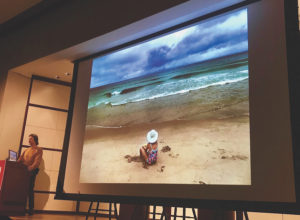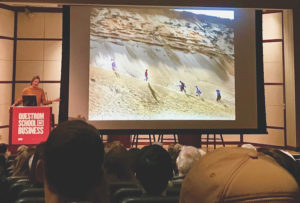BOSTON — The Boston Globe’s multimedia reporting project “At the Edge of a Warming World,” published with much fanfare last month, held few surprises for Cape Codders. Most of it was old news — yes, we’re experiencing erosion, flooding, storms, and biodiversity loss. Species are shifting their ranges. Fish stocks are dwindling, and special habitats for migratory birds are at risk.

But the team behind the project say that they intentionally sought an outsider audience, gearing it to readers who visit Cape Cod only during the summer and leave their worries behind at the Sagamore and Bourne bridges.
To follow up on the report and spur action on its findings, the newspaper sponsored a conference of journalists, climate scientists, and civic leaders on Oct. 22 in Boston. Globe narrative editor Steve Wilmsen said that climate coverage often makes the crisis seem remote.
“A lot of stories felt far away in the future and left me with a feeling of powerlessness,” Wilmsen said. He argued that New Englanders don’t really relate to polar bears.
“This was our way to make a story that was not remote or abstract, but real and tangible and part of all of our lives,” he said. The journalists wanted to make the crisis feel personal for readers by showing their treasured spots for beach fires, kayaking, or fried clams threatened by sea level rise and erosion.
With the Cape’s evocative landscapes as a backdrop, the Globe team hoped readers would both grasp the crisis’s severity and feel empowered to take action.
The article, photos, and videos have been hugely popular among readers, said Globe editor Brian McGrory. On the first day of its web release, the story had over 100,000 hits, and readers lingered for 10 minutes on average — considered a lengthy stay for online engagement. The Boston event also drew a sizable crowd of close to 300.
Cape Codders also enjoyed the article. Globe columnist Nestor Ramos told the Independent that he was surprised by the number of positive reviews from locals.
“I wanted to let folks tell their stories,” Ramos said. He conducted interviews from May to September for the project. “It was critically important to be faithful to their experience of the place and capture also how beautiful it still is and how much we should treasure it.”
Shifts in climate typically do not appear as new phenomena. Instead, climate change affects already existing processes by, for example, accelerating rates of erosion or increasing the intensity of storms.
Therefore, it wasn’t simple to capture climate change on camera.
Globe photographer John Tlumacki said this was his most difficult assignment to date. He returned to Cape sites multiple times in search of the perfect shot.
Tlumacki ended his presentation at the conference with an image of a girl playing in the sand as a storm builds on the horizon.

“I think I summed up climate change on Cape Cod in one photo,” he said. “We’re looking at present and future in the same photo. The threat of climate change is looming in the distance, but this girl doesn’t care. She just wants to have fun.”
Climate Justice and Equity
Other panelists discussed the implications of the Globe’s report.
State Sen. Julian Cyr of Truro said that, although Cape towns have been planning for climate change effects for years, the rate of change has been faster than anyone predicted.
“We have to make decisions today that we thought we’d make in 25, 50, or 100 years,” said Cyr. “Instead, we have to make those decisions in the next 5 to 10 years.”

In response to the article’s focus on coastal erosion and audience questions about sea walls, Cyr raised the issue of wealth inequity. Most local residents can’t afford to live on the edge of bluffs, he said, so protecting second homes of the wealthy is not his first priority.
“This is a place that has become profoundly unaffordable,” Cyr said. “Local folks are mostly living inland because that’s where the more affordable places are. Second, third, or fourth home owners often have this attitude: ‘I’m going to build that sea wall and not think about the repercussions.’ The adaptation that I’m focused on is not necessarily folks with homes on the coast.”
The issue of climate justice was also raised, primarily by students from Boston Latin School, who took the stage to briefly outline their responses to the article. Boston University Professor Cutler Cleveland pointed out that climate justice was not addressed until the very end of the event.
“The poor and people of color are disproportionately impacted [by climate change],” said Cleveland. “If you are not baking equity in at the very outset of your discussion, you’re ignoring it. And by definition it will get worse.”
The event concluded with a call to action.
Woods Hole Research Center senior scientist Linda Deegan said that people need to start showing up at select board meetings to demand that they take the climate crisis seriously. Deegan also pointed out that retreat from the coast will eventually be necessary.
Nationally, most flood insurance payouts cover the same five percent of buildings over multiple floods, Deegan said. “Clearly those are places that we shouldn’t be rebuilding,” she said. “We should limit the number of times you can rebuild in the same place after storm damage.
“Cape Cod is in a unique position to set an example for other parts of the U.S.,” Deegan concluded. “We’re on the cutting edge, the front line of climate change, and we have opportunities to change how people react to that.”



